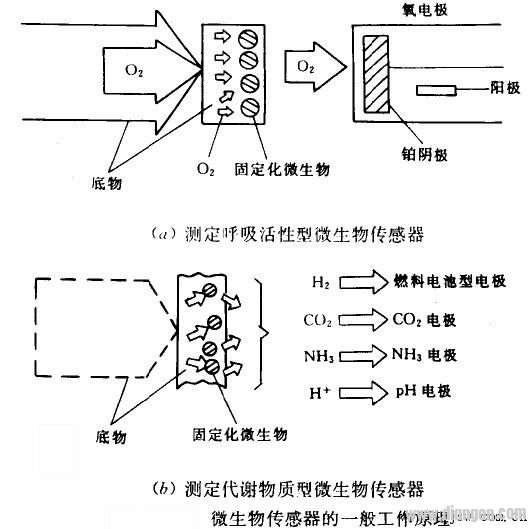Microbial sensors are based on the interaction between microorganisms and a test substance. There are two main types: one uses aerobic microorganisms as sensitive materials, and when they come into contact with an organic compound, their respiratory activity increases. This change in respiration can be measured to determine the presence and concentration of the compound, forming a respiratory-active microbial sensor. The basic working principle is illustrated in (a). In this setup, aerobic microorganisms are immobilized on a diaphragm-type oxygen electrode, creating a microbial electrode. When this electrode is placed in a solution containing an assimilable organic compound, the compound diffuses into the gel containing the microorganisms. Once assimilated, the microorganisms' respiratory activity increases, causing less oxygen to diffuse into the oxygen probe. As a result, the oxygen current decreases, allowing for the indirect measurement of the organic compound's concentration. Because of this current-based response, these sensors are typically classified as current-type microbial sensors. Another type involves oxygen-sensitive microorganisms that respond to changes in oxygen levels during metabolic processes. Molecular recognition can also occur by detecting metabolites produced during the assimilation of organic matter. This leads to the development of metabolite-type microbial sensors, as shown in Figure 12-36(b). If a specific small molecule generated during metabolism is the target for the electrode, the electrode acts as a signal transducer. Combined with a microbial membrane, it forms a complete microbial sensor that detects the concentration of the test substance. For example, hydrogen-producing bacteria can be immobilized in a polymer gel and used in a fuel cell setup. Here, the bacteria act as the anode, while silver peroxide (Ag₂O₂) serves as the cathode. When an organic compound enters the gel, the bacteria metabolize it and produce hydrogen. This hydrogen then diffuses to the anode, where it undergoes oxidation, generating a measurable electric current. The current is directly proportional to the amount of hydrogen produced, which in turn reflects the concentration of the original organic compound in the sample. This method offers a highly sensitive and specific way to detect various organic compounds. It’s particularly useful in environmental monitoring, biotechnology, and medical diagnostics. By using biological components like microbes, these sensors mimic natural processes, making them both efficient and environmentally friendly. The integration of biochemistry with electrochemical systems allows for real-time monitoring and accurate quantification of substances, enhancing the practicality and versatility of microbial sensing technology. Optical Filter,Long Wave Pass Filter,Optical Pass Band Filter,Bandpass Filter Danyang Horse Optical Co., Ltd , https://www.dyhorseoptical.com